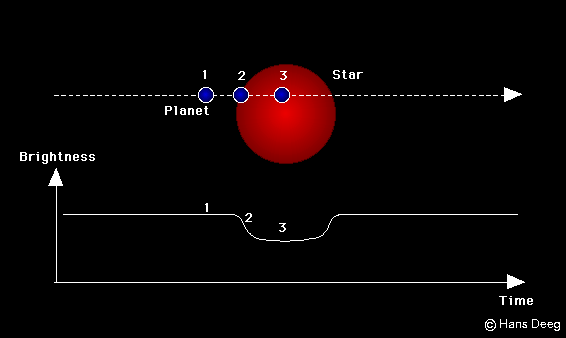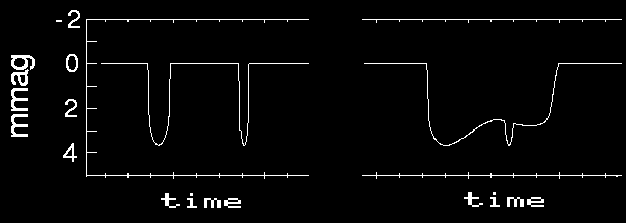The Transit Method

The transit method is based on the observation of a star's
small drop in brightness, that occurs when the orbit (dashed line) of one
of the star's planets passes ('transits') in front of the star The
amount of light lost -typically between 0.01% and 1%- depends on the sizes
of the star and the planet; and the duration of the transit depends on
the planet's distance from the star and the star's mass. Since the star's
mass and size can be determined from spectroscopic observations,
the planet's size and distance can be determined. Of course, a transit
has to occur once for every orbital revolution of the planet around the
star. This repeated occurrence of transits is the major diagnostic tool to
determine if an observed transit is really from a planet - it has to appear
once in each of the planet's 'year'.
The repeatability of transits gives also the opportunity
to observe a known transiting planet in the future with improved instrumentation
- one day it may be possible to examine a planet's atmosphere (by
spectroscopy of absorption lines from its atmosphere while it is transiting)
and check it for indicators of life - such as the presence of free oxygen
in the atmosphere.
In the TEP project, we are observing an
eclipsing binary star for transit signals. A planet in the plane of the
binary star would transit both components. This is symbolized in the logo
of the TEP network.

A variety of transit shapes can result from transits across
binary stars. They are a consequence from the variety of geometric configurations
that are possible, with the binary stars moving around each other, and
the planet moving around both.

This graph shows examples of brightness changes that could
be caused by a planet with 2 Earth Radii, transiting across both components
of CM Draconis. The vertical axis is labeled in milli-magnitudes; 1 mmag
is about 0.1% brightness change. Left is the 'normal' case with two dips
(one from each component) separated by a few hours; at right a is single
long transit - such as it could have occurred if CM Dra is in the configuration
shown by the TEP logo. With long-periodic planets, even more complicated
shapes and multiple transits may occur. The Fig.1 in the paper in Astronomy
& Astrophysics (1998, Vol 338, p 479, preprint in
postscript , pdf)
gives more examples of these transits. The unique shapes that planets would
cause in binary transits serve as an additional tool in the identification
of true planetary transits: Each planet (with a specific period and phase)
would cause a unique sequence of transits across CM Dra. Once some planet
candidate has been found, further transits, including their shapes, can
be predicted and verified by telescope observations.
The following two articles give a more detailed overview
about the transit method:
-
'Photometric Detection of Extrasolar Planets by the Transit
Method' (postscript,
pdf)
-
'Further Aspects of the Transit method' (postcript,pdf)
Additional articles can be found in the references.
 To the TEP home page
To the TEP home page
Last update: 25/Mar/2002. For comments, send email
to
Hans-Jörg
Deeg at hXdeeg@ll.iaXc.es (NOTE: remove the X from address)



